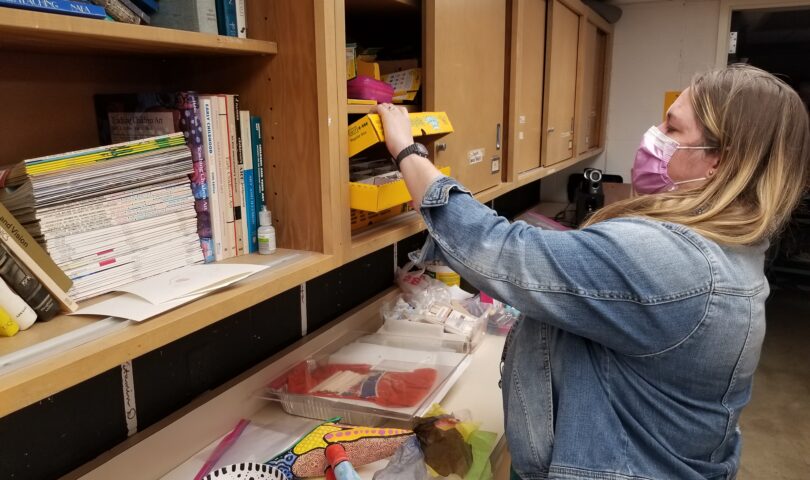WVU Today
At times, finding the right words can be difficult.
Helping people discover other ways to express themselves is the focus of several students at West Virginia University who, for the first time this fall, are working toward undergraduate degrees in art therapy.
The curriculum was developed by Annie McFarland, assistant professor of art education in the College of Creative Arts.
“Using art and art-making processes allows people to create visual images about their personal experiences that can act as a holding place for trauma and as a way to open up dialogue,” McFarland said. “The art often expresses more than a person can verbalize, so it really gives a fuller picture of what’s going on in their inner world by externalizing their thoughts, emotions, and ideas through the art itself.”
The new degree program in the School of Art and Design blends studio art training with psychology and counseling courses to provide future graduates foundations for pursuing careers in the field of art therapy, using visual art mediums to target therapeutic issues.
Potential art therapy mediums include drawing, painting, clay sculpting, photography, collage work and, McFarland’s chosen medium and the focus of her dissertation, papermaking.
“Which art materials you use depends on the therapeutic goals, but any medium you would use in the visual arts, you can use in art therapy,” McFarland said. “Anywhere you would see a therapist working with any specific population, an art therapist can essentially be there too.”
McFarland said art therapy has been shown to be beneficial in many therapeutic settings and is becoming more popular as a treatment option to address anxiety, substance use disorders, trauma recovery and other issues.
The art supports and informs the therapist and can also be used as a tracking tool to measure progress.
“For me, it is really this beautiful bridge between art and healing through a modality that goes beyond talk therapy,” McFarland said of the field in which she’s found her purpose.
The pursuit of such purpose is now a university-wide effort elevated by a planned Purpose Institute on campus.
“We must pursue education, healthcare and prosperity with a renewed and focused determination to transform West Virginia University into a purpose-driven leader in higher education,” President Gordon Gee said in his recent State of the University Address.
“We do our work not just for ourselves, but for others. That is different than other institutions and I should know. Having that sense of purpose is special. Now is our time to fully embrace that feeling and turn it into action.”
Originally employed as a graphic designer, McFarland went back to school after being laid off from a previous job.
“I was really looking for a meaningful way to work with people, connect with others, and help creatively with healing,” she said.
“There’s a huge need for art therapy education and art therapy, in general, in West Virginia and our region. It just makes sense to have this degree as a starting point for many students who come to WVU looking for careers in the healing and creative arts.”
In addition to art therapy, using art as a form of self-expression and communication can be beneficial in a variety of disciplines.
McFarland’s instructional work also includes teaching in art education for future teachers on campus along with off campus workshops for community members.
By early 2022, McFarland said she is hoping to be able to take art therapy into the WVU Cancer Institute for new research focused on stress levels of patients who make art while receiving treatments.
“I definitely feel that through teaching and connecting to disciplines outside of the field of art therapy at WVU is where I found my purpose,” McFarland said.
“It’s really a beautiful way to work on a variety of goals — emotional, psychological, therapeutic issues — that people need assistance for from all walks of life.”
TWEET @DominionPostWV




